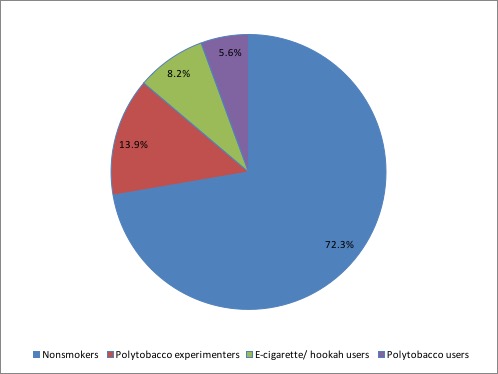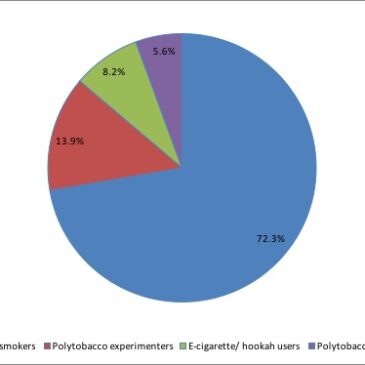Editor’s note: As part of our broader effort to streamline our science reviews, we have changed the way we provide citations to academic papers. Rather than presenting a list of references at the end of science reviews, we now link directly to published abstracts of these papers within the main text. Readers can click on these links to learn more details about the papers.
Cultural shifts and new technologies are setting the stage for potentially dramatic changes in how people use tobacco. This might be particularly risky for young people, who might start using tobacco because they believe these new delivery systems are safer or are more acceptable than traditional forms of tobacco such as cigarettes. This week’s ASHES reviews a study by Tamika Gilreath and colleagues that examined patterns of tobacco use among 11th and 12th grade youth who participated in the Southern California Children’s Health Study.
What was the research question?
What are the patterns of tobacco use among youth in Southern California? And are certain groups of students at particular risk for specific patterns of tobacco use?
What did the researchers do?
The researchers conducted secondary data analysis using data about tobacco use from the 2014 wave of the Southern California Children’s Health Study. The final sample included 2,091 students who completed the survey measures on tobacco use. The survey asked students to report if and when they started using 5 different types of tobacco products: 1) cigarettes; 2) cigars/cigarillos/little cigars; 3) e-cigarettes; 4) hookah/waterpipe; and 5) smokeless/dip/chewing tobacco. For each tobacco type that students reported ever using, they were then asked if they were current users (past 30 days). Based on these responses, researchers then categorized students into never, ever, or current users for each product. The researchers used Latent Class Analysis to group students based on their patterns of tobacco use.
What did they find?
As the Figure shows, the majority of students (72.3%) were nonsmokers with a low probability of ever having tried any of the 5 types of tobacco. The second largest group, comprising 13.9% of the sample, were “Polytobacco Experimenters” who had a high probability of ever using more than one type of tobacco, but a low probability of being current users. The third largest group, comprising of 8.2% of the sample, were “E-cigarette/hookah users” who had a high probability of being current e-cigarette or hookah users. The final and smallest group was comprised of 5.6% of the sample who were “Polytobacco Users” with a high probability of being current users for 4 out of the 5 types of tobacco. Compared to female students, male students were 2.3 times more likely to be “Polytobacco Users” than non-tobacco users.

Figure. Conditional probabilities of tobacco use among 11th and 12th grade students from the Southern California Children’s Health Study, 2014. Adapted from Gilreath et al., 2016. Click image to enlarge.
Why do these findings matter?
To better protect the health of students, it is important to understand the patterns of their tobacco use. These findings indicate that approximately 28% of students are experimenting with or currently using tobacco products. In each of the two classes of current tobacco users, youth had the highest probability of current use of e-cigarettes and hookahs. These findings suggest tobacco prevention and treatment programs ought to address polytobacco use with an emphasis on emerging trends in tobacco use instead of focusing on a single type of tobacco product.
Every study has limitations. What about this one?
The study did not include measures of frequency or quantity of tobacco use nor concentrations of nicotine in the hookah or e-cigarettes, so we do not know much about how these students are using the tobacco types they choose. The study was based on 11th and 12th graders from select schools in southern California. This limits generalizability to students of other ages or to students in other regions who might have different levels of exposure and access to tobacco products.
For more information:
Click here to find a free, self-help tool for changing your tobacco use. For additional tools, please visit the BASIS Addiction Resources page.
–John H Kleschinsky
What do you think? Please use the comment link below to provide feedback on this article.




